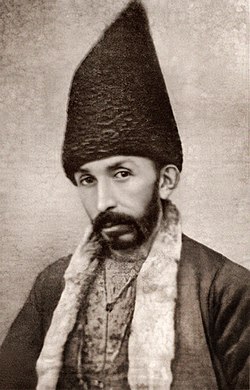Mir Mohsun Navvab

Mir Möhsün Nəvvab | |
|---|---|
 Mir Mohsun Navvab during work | |
| Born | 1833 Shusha, Karabakh province, Russian Empire |
| Died | 1918 Shusha, Transcaucasian Democratic Federative Republic |
| Nationality | ethnic Azerbaijani |
| Genre | Lyric poetry, Calligraphy, Painter |
Mir-Mohsun Navvab (Azerbaijani: Mir Möhsün Nəvvab) (1833–1918 in Shusha, present day Azerbaijan) occupies a prominent place in the history of Azerbaijani culture as the last representative of the old traditional school of science, arts and literature.[1] Navvab was versatile person of his time. He is known as a poet, artist, music historian, astronomer, carpenter, chemist and mathematician.
Navvab was born in 1833 in Shusha and spent his life in this city.[2] His life and works reflect a period of history when Azerbaijan was on the turning point of old and new, traditional and novel trends in culture and general way of life. Although Navvab remained a traditionalist in the arts, he was a progressive person in the public life of Karabakh who did a lot for the growth of literacy, culture, and arts in Karabakh.
Navvab was a famous calligrapher in Shusha. He published the poems of Karabakh poets and spread them among the local population. Navvab established a second literary society in Azerbaijan called the Majlis-i Faramushan "Society of the Forgotten" and the first music society, Majlis-i Khanende "Society of Singers".
Navvab wrote more than 20 books dedicated to various fields of science and arts. He is the author of the Vuzuh al-Argam "Explanation of the numbers", a significant work which offers 82 maqams (an original improvisational classical folk music popular in Azerbaijan) and songs performed in Karabakh at that time.[3] He also provides information about the origins of these mugams and the rules for their performance. Navvab is also the author of the book Tezkirey-i-Navvab, which gives information about one hundred poets and writers of Karabakh at the time.
He also authored an eyewitness account of Armenian–Tatar massacres of 1905–1907 titled Tavārīkh-i razm u shūrish-i ṭāʾifa-yi arāmana bā musalmānān-i Qafqāz "The chronicle of battles and riots of the Armenian people against the Muslims of the Caucasus" around 1906. He identified Armenian nationalists as the main source of trouble for both sides, nevertheless mostly blaming the Social Democrat Hunchakian Party.[4]
Navvab was also a talented artist. He illustrated his manuscripts with colorful pictures and portraits and also decorated the interiors of the buildings with various ornaments. Before the 1992 Battle of Shusha, some of these wall decorations were preserved in the house where he lived, the school where he taught, and the minarets of the Shusha's Yukhari Govhar Agha Mosque. Navvab died in 1918 in Shusha fortress.
See also
[edit]References
[edit]- ^ "MİR MÖHSÜN NƏVVAB VƏ ONUN ELMİ İRSİ". xezer.libmks.az (in Azerbaijani). Archived from the original on 2 July 2014. Retrieved 29 June 2014.
- ^ "Qarabağ ədəbiyyatı: xronoqraf > XIX əsr > Mir Möhsün Nəvvab". azerbaycanli.org (in Azerbaijani). Archived from the original on 26 April 2018. Retrieved 29 June 2014.
- ^ Miklashevskaya, Nadejda (1954). "4". Soviet Encyclopedia. pp. 102–108.
- ^ Rahimi Bahmany, Leila, "1905–1906-cı illərdə erməni-müsəlman davası", Christian-Muslim Relations 1500 - 1900, Brill, retrieved 2023-12-30